|
I thoroughly enjoyed
working at the Lockheed-California Company Rye Canyon Research and
Development Center, Saugus, California.
One of my independent research and development reports was LR27399,
"Correlation of Failure Analysis Data: Pitting Corrosion". I was assigned to work
in the Life Sciences Bldg. Here below the Last.fm link is a copy of report LR27399, page 1.

| During July 2001, I received comments from Robert Heidersbach about
my work on statistics of corrosion pit depths. He was then Professor and Chair,
Materials Engineering, at Cal Poly. He was also Technical Editor, Corrosion-the-Online Corrosion Journal, http://www.corrosionsource.com/corrosioneering/index.html.
Because of encouragement extended by Prof. Heidersbach, I decided to
post a report online. It is titled "Correlation of Failure Analysis Data:
Pitting Corrosion".
This note was posted on October 20, 2001.
On September 29, 2004, he forwarded a note about the course. The note listed the address:
Bob Heidersbach
Dr. Rust, Inc.
Cape Canaveral, Florida
drrustinc@earthlink.net
|
|
In this website, I use methods described in 1975 report LR27399 to present an application of my Weibull Trending Toolkit(WTT). Files updated in July 2003 are: wtt01.html, wtt02.html, and wtt03.html
Updated references are:
wtt01.html
wtt02.html
wtt03.html
|
|
Weibull Trending Toolkit
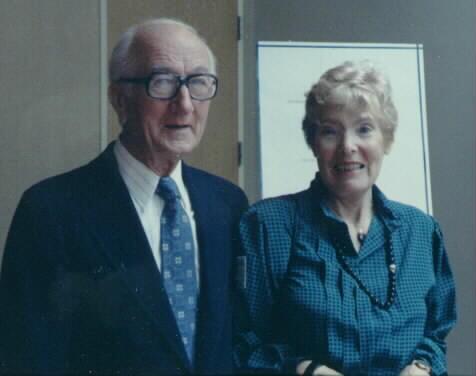 |
|
Dedicated to dear friends Kitty (Gusta) and Walter
Trapp. Walter died February 19, 2002. |
|
Tribute to Waloddi Weibull
During June 1996, I asked Walter J. Trapp to help me in
writing to Mrs. Inga Britta (Ibbi) Weibull. I remembered Walter telling
me about Waloddi Weibull having received an award from King Gustav of
Sweden, and I wished to include an image of the event in this tribute.
Waloddi Weibull devoted his entire professional life to studying
ways to increase our understanding of material sciences. He was a
soldier-engineer who gave his utmost to improve our use of materials. I
sent a note of thanks to Mrs. Ibbi Weibull and to Göran Weibull in
remembrance of husband and father, Waloddi Weibull.
 Waloddi Weibull 1887-1979
Photo by: Sam C. Saunders, Pullman Washington, USA
Waloddi Weibull 1887-1979
Photo by: Sam C. Saunders, Pullman Washington, USA
The above photograph is a copy from the first page of a document from
the Weibull Symposium, Stockholm, 1984. The reference: "IUTAM Symposium,
to the memory of Waloddi Weibull. Probabilistic Methods in the Mechanics
of Solids and Structures, Stockholm, June 19-21, 1984. Organized by: The
Aeronautical Research Institute of Sweden, FFA, in cooperation with The
Swedish National Committee for Mechanics."
On 18 Sept. 1996, I received the following letter from Mrs. Ibbi
Weibull and Göran Weibull:
|
Genarp, Sweden 13 Sept. 1996
Dear Dr. Bowie,
We, that is Mrs. Weibull and Göran W. Weibull, have received and read
your kind letter 0f 20 August 1996. We are happy to contribute to your
idea of giving better information into Internet about Waloddi Weibull.
His full name is Ernst Hjalmar Waloddi Weibull. The name Waloddi
was shortened to Doddi in the family and by close friends.
After some research we have found an appropriate text in a report
from IUTAM Symposium to the memory of Waloddi Weibull, Stockholm, 19-21
June 1984, written by Dr. Robert A. Heller. A copy of the first page of
the report and Dr. Heller's speech are enclosed. Perhaps you can use the
photograph from the first page.
We know Robert Heller very well and have found his speech very
enjoyable. The information about Waloddi is absolutely correct.
Actually, Mrs. Weibull has written a letter to him and asked for
permission to use it.
If the text is too long, perhaps you can make an excerpt. If you have
any questions don't hesitate to get in touch. You will find addresses at
the end of the letter.
You put two questions in your letter, and these are the answers:
- Hans Waloddi was the eldest son and
- I, Göran Waloddi, child number 5, started as an officer of the
Royal Wendes Artillery Regiment and later transferred to The research
Institute of National Defense as a researcher mainly concerned with
weapons effects.

Enclosed is the
photo with King Carl XVI Gustav of Sweden, Waloddi Weibull, and in the
middle Gunar Hambræus, then President of the Royal Swedish Academy of
Engineering. When Waloddi stood in front of the King he said:
"Seventy-one years ago I stood in front of Your Majesty's grandfather's
grandfather (King Oscar II) and got my officer's commission." The King
then said: "That is fantastic!"
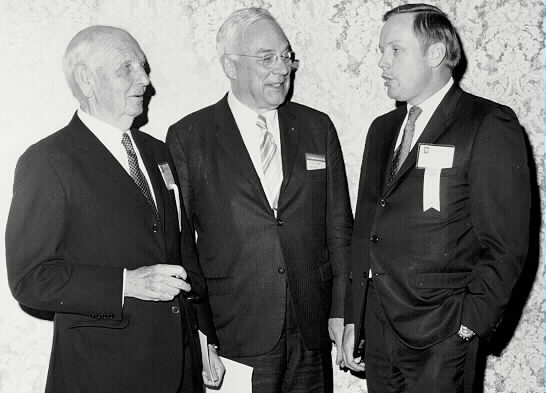
Another photo is
enclosed. It is from 1972 when he got the ASME Medal. Waloddi is on the
left, in the middle Dr. Richard Folsom, and to the right Neil Armstrong,
who got the Spirit of St. Louis Medal.
With best wishes,
Ibbi Weibull
Björnstorps torg
S - 240 13 Genarp
SWEDEN
Göran W. Weibull
Bäckamöllan
S - 277 55 BRÖSARP
SWEDEN
There follows an exerpt from Dr. Robert A. Heller's speech
to the Weibull Symposium, Stockholm, 19-21 June 1984. I beg Dr. Heller's
understanding in presenting the exerpts in advance of receiving word of
his approval from Mrs. Ibbi Weibull.
THE WEIBULL DISTRIBUTION DID NOT APPLY TO ITS FOUNDER
Robert A. Heller, Roanoke, Virginia, USA
Though it is an honor to have been asked by the Chair to talk about
Professor Weibull, I am saddened that my substitution is occasioned by
the untimely passing of another great engineer, Professor Folke Odquist,
who was to give us his impressions of his old friend and colleague.
The information I have gathered about Professor Weibull comes from
several sources: from his friends; Professor Odquist, Walter Trapp of
the US Air Force, Professor Sigge Eggwertz of FFA, from his family; Mrs.
Ibbi Weibull, his wife, and Mr. Göran Weibull, his son, and my own
personal recollections.
Waloddi Weibull was born on June 18, 1887. This Symposium started on
his 97th birthday. His family originally came from Schleswig-Holstein,
at that time (in the seventeenth century) closely connected with
Denmark. There were a number of famous scientists and historians in the
family. His own career as an engineer and scientist is certainly an
unusual one.
He became a midshipman in the Royal Swedish Coast Guard in 1904 and
was promoted to sublieutenant in 1907, to Captain in 1916 and to Major
in 1940. By then he had finished the military schools and simultaneously
taken courses at the Royal Institute of Technology and at Stockholm
University, finally graduating as Fil.Lic. in 1924. Weibull left active
military service in 1917 and acted in German and Swedish industries as
an inventor (ball bearings, electric hammers) and as a consulting
engineer.
He published his first scientific paper on the propagation of explosive
wave in 1914. He took part in expeditions to the Mediterranean, to the
Carribean, and to the Atlantic and Pacific Oceans on the research
"Albatross" where he used his newly developed technique of explosive
charges to determine the type of ocean bottom sediments and their
thickness. The same method is used today in offshore oil explorations.
Weibull became a full professor at the Royal Institute of Technology
in 1924, and was awarded the degree Ph.D.h.c. at the University of
Uppsala in 1932. In 1941 a donation from the Swedish arms factory (A. B.
Bofors) gave him a personal research professorship in Technical Physics
at the Royal Institute of Technology, Stockholm.
Professor Weibull's ideas about the statistical distributions of
material strength came to the attention of engineers in the late 1930's
with the publications of two important papers: "Investigations into
strength properties of brittle materials" and "The phenomenon of rupture
in solids."
His techniques later found wide application in many fields. With
great physical insight he proposed the probability distribution which
bears his name. Now, in the literature on reliability, statistics,
fatigue, fracture and many other fields, one finds reference to the
"Weibull Distribution", and the statistic methods Weibull proposed are
in everyday use. Subsequently, Dr. Weibull extended his studies to many
aspects of fatigue, fracture and the analysis of probability
distributions.
In 1953 he retired from the Royal Institute of Technology and became
a professor emeritus. For most people retirement is the end of a
professional career, but not for Weibull. His activities just started.
He became a consultant to the Fatigue Branch of the U.S. Air Force
Materials Laboratory, then under the direction of Mr. Walter Trapp. For
14 years he conducted research and wrote many papers and technical
reports which provide valuable information and data on material
properties and on the analysis of probability distributions and other
related topics. This and other work is summarized in a book, co-authored
with his son Goran and published by the Swedish National Defense
Research Institute. Professor Weibull continued to be active as a
consultant. He conducted work on turbine fatigue and studied new methods
of estimating the parameters of the Weibull Distribution. His work on
the planning and interpretation of fatigue data is monumental and
resulted in his book "Fatigue Testing and Analysis of Results" in 1961.
In 1963, at the invitation of the late Professor Alfred Freudenthal,
he became a visiting Professor at Columbia University's Institute for
the Study of Fatigue and Reliability. Many of us at this Symposuim have
been associated with the Institute at that time and got to know Dr.
Weibull personally. Hal Liebowitz was one of our sponsors. Alf Payne,
Agnes Heller, Jann Yang, Lars Jarfall and I learned a lot from him, from
Emil Gumbel, who was also a member, and from Fred Freudenthal, the three
founders of Probabilistic Mechanics of Structure and Materials. It was
interesting to watch the friendly rivalry between Gumbel, the
theoretician and the two engineers, Weibull and Freudenthal.
The Extreme Value family of distributions, to which both the Gumbel
and Weibull type belong, is most applicable to materials, structure and
biological systems because it has an increasing failure rate and can
describe "wear out" processes. Well, these two men, both in their late
seventies at the time, showed that these distributions did not apply to
them. They did not wear out but were full of life and energy. Gumbel
went skiing every weekend and when Agnes and I took Dr. and Mrs. Weibull
to the Roosevelt Home in Hyde Park on a cold winter day, he refused my
offered arm to help him on the icy walkways saying: "A little ice and
snow never bothered a Swede."
In the course of his long and productive career, Professor Weibull
has received many honors: the Polhem Medal in 1940, an honorary
doctorate from the University of Uppsala in 1932, and in 1972, the
American Society of Mechanical Engineers awarded him the ASME medal with
the inscription: "A pioneer in the study of fracture, fatigue and
reliability who has contributed to the literature for over thirty years.
His statistical treatment of strength and life has found wide-spread
application in engineering design."
The other recipient of a medal at the sme meeting, Astonaut Neil
Armstrong, the first man on the moon, probably did not know that his
successful voyage was partly due to the pioneering work of Waloddi
Weibull.
Professor Weibull's proudest moment came in 1978 when he received the
Great Gold Medal from the Royal Swedish Academy of Engineering Sciences
which was personally presented to him by King Carl XVI Gustav of Sweden.
He was devoted to his family and was proud of his nine children and
numerous grand- and great-grandchildren. Dr. Weibull was a member of
many distinguished Swedish Academies and Societies and worked to the
last day of his remarkable life. He died on October 12, 1979, in Annecy,
France.
|
|
Here is a way to test your interest level.
Accomplish the following busy work.
- Save executable file wtt01.exe in directory wtt01.
- Enter http://weibull.trending.toolkit.tripod.com/6061.txt. Save as a text file in
directory wtt01.
- Rename 6061.txt to be 6061.dat.
- Repeat for data file 7075.dat.
- Check to see if you have Vbrun300.dll in your Windows/System
directory.
If not search the Web for Vbrun300.dll and install it.
Run wtt01.exe, see two buttons: Match Sample Statistics and Plot
Control Chart.
Click the Match button and enter 6061. Study the
results. Click the Plot button
and enter 800. Repeat for 6300 and 7075.
Use 80 or 100 for 7075 graph upper limit.
Write to me if you have comments or need help. I refer to notes on use
of wtt01.exe as Course
I Three QBasic programs mentioned in the notes are stored
here as makefile.txt, and sort.txt. Save these two text data files, then Rename them to have file
extension .bas.
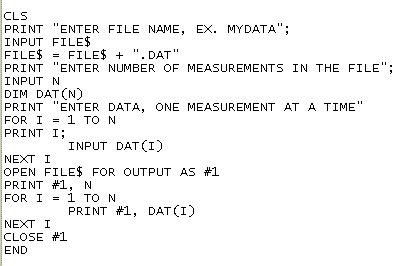

To learn how useful the Weibull Trending Toolkit can be
read:
Course II, On Pitting Corrosion; http://weibull.trending.toolkit.tripod.com/wtt02.html
Course III; On Cracks, Fracture, and Crack Growth: http://weibull.trending.toolkit.tripod.com/wtt03.html
Use the above results for 6061.dat to apply Risk.bas. Treat the example
to be a risk design application with production run size 102.
CLS
PRINT "Enter Weibull Shape Parameter k:";
INPUT k
PRINT "Enter Weibull Threshold Parameter e:";
INPUT e
PRINT "Enter Median Design Value:";
INPUT Median
v = e + (Median - e) / (LOG(2)) ^ (1 / k)
PRINT "Weibull Characteristic Value ="; v
PRINT "Enter production run size N:";
INPUT N
PRINT "Probability of survival at first failure =";
P = 1 - 1 / 1 / (N + 1)
PRINT P
PRINT "Time to first failure =";
t = e + (v - e) * (-LOG(P)) ^ (1 / k)
PRINT t
PRINT "Risk of failure at time"; t; "equals";
R = k * ((t - e) / (v - e)) ^ (k - 1) / (v - e)
PRINT R
PRINT "Probability density at time t =";
DENSITY = R * P
PRINT DENSITY
PRINT "Probability of survival at second failure =";
P = 1 - 2 / 1 / (N + 1)
PRINT P
PRINT "Time to second failure =";
t = e + (v - e) * (-LOG(P)) ^ (1 / k)
PRINT t
PRINT "Risk of failure at time"; t; "equals";
R = k * ((t - e) / (v - e)) ^ (k - 1) / (v - e)
PRINT R
PRINT "Probability density at time t =";
DENSITY = R * P
PRINT DENSITY
PRINT "Probability of survival at median life = 0.5"
PRINT "Design median life ="; Median
PRINT "Risk of failure at median life equals";
R = k * ((Median - e) / (v - e)) ^ (k - 1) / (v - e)
PRINT R
PRINT "Probability density at median life =";
DENSITY = R * .5
PRINT DENSITY
PRINT "Probability of survival at failure"; N; "equals";
P = 1 - N / (N + 1)
PRINT P
PRINT "Time to failure"; N; "equals";
t = e + (v - e) * (-LOG(P)) ^ (1 / k)
PRINT t
PRINT "Risk of failure at time"; t; "equals";
R = k * ((t - e) / (v - e)) ^ (k - 1) / (v - e)
PRINT R
PRINT "Probability density at time t =";
DENSITY = R * P
PRINT DENSITY
END
Results of running QBasic program Risk.bas

It is possible to generate 102 design times to failure and store them
in file d6061.dat. Use the following values found by means of wtt01.exe
for measured data 6061.dat:
k=3.61498
e=195.1232
Median=398.3941.
Use program Wdesign.exe to find the following results.
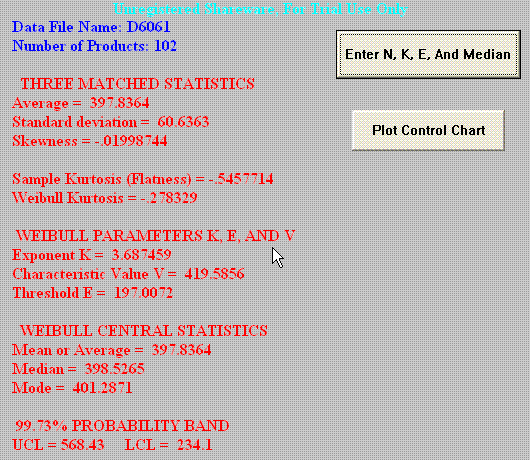
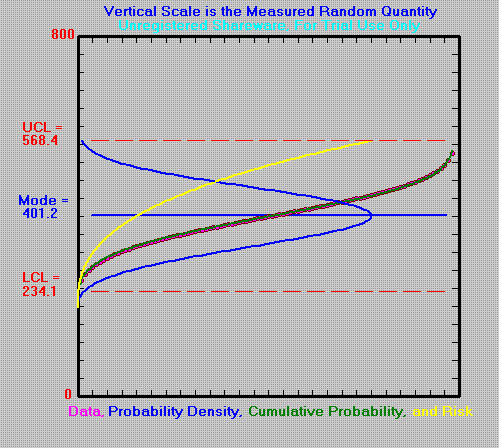
Weibull Trending Toolkit resources:
Carnegie Mellon University: http://lib.stat.cmu.edu/DOS/general
WTT
The Weibull Trending Toolkit (WTT) is described and applied in
three self-extracting files, WTT01.EXE(52k), WTT02.EXE(484k) and
WTT03.EXE(1M) QBasic programs in WTT may be executed from DOS or
Windows.
|
From 1987-92, I, Glenn E. Bowie, created the first two-year Associate Degree Program at Red Wing Technical College. The program name was Vibroacoustics Technology. There were 27 courses in the program. I created and taught 21 of them. In recognition of the quality of the progam, the 1992 graduating class members were granted their Associate Degrees in Vibroacoustics Engineering Technology. The reference is
Vibroacoustics Engineering Technology.
|
|



